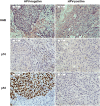Clinical characteristics, HIV status, and molecular biomarkers in squamous cell carcinoma of the conjunctiva in Ghana
- PMID: 30809594
- PMCID: PMC6375545
- DOI: 10.1002/hsr2.108
Clinical characteristics, HIV status, and molecular biomarkers in squamous cell carcinoma of the conjunctiva in Ghana
Abstract
Background and aims: Conjunctival squamous cell carcinoma (CSCC) varies in incidence geographically from 0 to 1 case per 100 000 per year globally. Additionally, the incidence of CSCC is known to increase 49% for every 10° decrease in latitude. Since the onset of the AIDS epidemic, there has been a trend of increasing incidence of CSCC in Africa, and despite relatively stable levels of ultraviolet (UV) exposure, there is an observed 12 times greater risk of developing CSCC when individuals are infected with HIV. In this study, we aim to analyze the clinical characteristics and biomarkers of CSCC in Ghana.
Methods: In this study, a registry review of patients from January 2011 to May 2016 with CSCC at Komfo-Anokye Teaching Hospital in Kumasi, Ghana, was performed (n = 64). Tumor blocks of the CSCC were analyzed for the expression of various biomarkers.
Results: In this study, the median age of onset of CSCC is 46.5 years old (range of 20-90 y old). Fifty one and a half percent (n = 33) of the cohort is female. There is a low rate of smoking and alcohol use in our CSCC cohort. Thirty-nine percent (n = 12) of Ghanaian men with CSCC are HIV-, while only 12% (n = 4) of women are HIV-. Fifteen patients had metastasis to lymph nodes or other tissues, and we observed a statistically significant relationship between HIV infection and metastasis (P = 0.027, chi-squared test). We observed no statistically significant relationship between known prognostic CSCC biomarkers and HIV status, age, or tumor stage.
Conclusion: Better characterization of CSCC could have a profound impact on the prevention, early identification, and treatment of CSCC in Africa. A retrospective chart analysis and collection of tumor samples can be challenging in this region due to methods of record keeping and stigma attached to clinical data such as HIV testing and smoking and alcohol use. As a result, in this study, data were often incomplete leading to inconclusive results and analysis that should be interpreted with caution. Future studies should consider a prospective study design that gathers clinical data in a standardized format and ensures fresh tissue from CSCC tumors.
Keywords: CSCC; Ghana; HIV/AIDS; viral oncology.
Figures




Similar articles
-
Incidence and epidemiology of conjunctival squamous cell carcinoma in relation to the HIV epidemic in South Africa: a 25-year analysis of the National Cancer Registry (1994-2018).Br J Ophthalmol. 2024 Jan 29;108(2):175-180. doi: 10.1136/bjo-2022-322456. Br J Ophthalmol. 2024. PMID: 36517211
-
The African AIDS case definition and HIV serology in medical in-patients at Komfo Anokye Teaching Hospital, Kumasi, Ghana.West Afr J Med. 1994 Apr-Jun;13(2):98-101. West Afr J Med. 1994. PMID: 7803336
-
Assessment of Cutaneous Squamous Cell Carcinoma (cSCC) In situ Incidence and the Risk of Developing Invasive cSCC in Patients With Prior cSCC In situ vs the General Population in the Netherlands, 1989-2017.JAMA Dermatol. 2020 Sep 1;156(9):973-981. doi: 10.1001/jamadermatol.2020.1988. JAMA Dermatol. 2020. PMID: 32609322 Free PMC article.
-
Cutaneous Squamous Cell Carcinoma: A Review of High-Risk and Metastatic Disease.Am J Clin Dermatol. 2016 Oct;17(5):491-508. doi: 10.1007/s40257-016-0207-3. Am J Clin Dermatol. 2016. PMID: 27358187 Review.
-
Staging for cutaneous squamous cell carcinoma as a predictor of sentinel lymph node biopsy results: meta-analysis of American Joint Committee on Cancer criteria and a proposed alternative system.JAMA Dermatol. 2014 Jan;150(1):19-24. doi: 10.1001/jamadermatol.2013.6675. JAMA Dermatol. 2014. PMID: 24226651 Review.
Cited by
-
Conjunctival cancer in people living with HIV.Curr Opin Infect Dis. 2021 Feb 1;34(1):1-7. doi: 10.1097/QCO.0000000000000705. Curr Opin Infect Dis. 2021. PMID: 33337616 Free PMC article. Review.
-
Human papillomavirus-related neoplasia of the ocular adnexa.Acta Ophthalmol. 2022 Oct;100 Suppl 272(Suppl 272):3-33. doi: 10.1111/aos.15244. Acta Ophthalmol. 2022. PMID: 36203222 Free PMC article.
-
Epstein-Barr Virus, But Not Human Papillomavirus, Is Associated With Preinvasive and Invasive Ocular Surface Squamous Neoplasias in Zambian Patients.Front Oncol. 2022 Apr 14;12:864066. doi: 10.3389/fonc.2022.864066. eCollection 2022. Front Oncol. 2022. PMID: 35494029 Free PMC article.
-
Conjunctival squamous cell carcinoma with massive apoptosis and immune cell infiltration: A case report.Front Surg. 2022 Oct 14;9:1004554. doi: 10.3389/fsurg.2022.1004554. eCollection 2022. Front Surg. 2022. PMID: 36311937 Free PMC article.
-
Human Papillomavirus Related Neoplasia of the Ocular Adnexa.Viruses. 2021 Aug 2;13(8):1522. doi: 10.3390/v13081522. Viruses. 2021. PMID: 34452388 Free PMC article. Review.
References
-
- Cancer incidence in five continents, Vol. XI (electronic version). In Lyon: International Agency for Research on Cancer.
-
- Yin VT, Merritt HA, Sniegowski M, Esmaeli B. Eyelid and ocular surface carcinoma: diagnosis and management. Clin Dermatol. 2015;33(2):159‐169. - PubMed
-
- Yousef YA, Finger PT. Squamous carcinoma and dysplasia of the conjunctiva and cornea: an analysis of 101 cases. Ophthalmology. 2012;119(2):233‐240. - PubMed
-
- Newton R, Ferlay J, Reeves G, Beral V, Parkin DM. Effect of ambient solar ultraviolet radiation on incidence of squamous‐cell carcinoma of the eye. Lancet (London, England). 1996;347(9013):1450‐1451. - PubMed
Grants and funding
LinkOut - more resources
Full Text Sources
Research Materials

